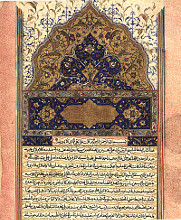Impact
Post-Avicennian Islamic Philosophy; Avicenna's Opera; Specific Website
Besides the three main benefits mentioned in the Introduction, the successful performance of the aforementioned objectives are expected to have the following specific impacts.
(I1) History of Islamic Philosophy – The attentive study of the manuscript tradition of a highly influential work like the Ilāhiyyāt is the surest way to map the reception of Avicenna’s metaphysics and, concomitantly, to canvass the development of Arabic philosophy. This kind of study represents an objective standard to evaluate more precisely the periods, trends and authors of Arabic philosophy: if we think, for example, that Averroes’ Long Commentary on the Metaphysics is preserved in only one Arabic manuscript, whereas Avicenna’s Ilāhiyyāt is transmitted by more than one hundred codices, ranging from the 12th until the 20th century, we immediately realize that the old “Western” perspective according to which Avicenna and Averroes are authors of equal importance, after whom Arabic philosophy started to decline, is not tenable. By compelling scholars to assess the “when”, “where”, and “by whom” of the copy of manuscripts, the codicological study is one of the most effective factors conveying the “contextualization” of historiography, i.e. the transformation of the current research in Arabic philosophy, still too often a doxographical enterprise, into a real history of a cultural event of paramount relevance. Likewise, the study of the indirect tradition of the work will shed light on the explanation, endorsement or criticism of Avicenna’s metaphysics by subsequent philosophers.
(I2) Avicenna’s Œuvre and the Latin Reception of the Ilāhiyyāt – The apparatus of loci paralleli, as well as the doctrinal introductions to the work and to its single treatises and the running commentary, will allow a more accurate evaluation of the metaphysics of other works of Avicenna. More in general, the present project can serve as a starting-point and a feasibility study for future attempts to edit, translate, and comment other sections of the Šifāʾ: many manuscripts containing the Ilāhiyyāt and stored into the database do, in fact, encompass the Šifāʾ in its entirety, so that the study of the stemmatic relation of codices in the case of the Ilāhiyyāt will cast light on the ways of the manuscript diffusion of Avicenna's summa, and by means of the database scholars will get access to codicological information and images of other parts of the Šifāʾ . Avicenna’s philosophical masterpiece is known to the West only partially and imperfectly: its integral presentation will help revealing to Western culture the width and articulation of the thought of this giant of the history of philosophy, thus allowing a substantial improvement of our current understanding of Arabic philosophy and culture.
Object of particular attention will be the Latin medieval translation, in order to ascertain the manuscript tradition on which this latter depends, assess the peculiarities of the Latin version with regard to the Arabic original and try to ascertain the identity of the Latin translator. Indexes and lexica will provide exhaustive materials for hitherto neglected studies in Avicenna's terminology.
(I3) A Dedicated and Versatile Website – Availability of primary sources, and exchange of information among scholars specialized in the different areas of Avicenna’s thought, are crucial for the progress of the research on this giant of the history of philosophy. Being also a physician and a versatile scientist, Avicenna is one of the Arabic philosophers most extensively studied: Avicennian scholars are spread nowadays in the five continents, and perform their research according to a multiplicity of different languages, interests, and approaches, which still demand to be reciprocally connected and integrated into a coherent system. The projected website intends to meet these two needs, and to represent a prototype for the creation of similar websites centered on individual Arabic philosophers (see, for instance, http://ghazali.org/).
Philosophy on the Border of Civilizations and Intellectual Endeavours:
Towards a Critical Edition of the Metaphysics (Ilâhiyyât of Kitâb al-Šifâʾ) of Avicenna (Ibn Sînâ)
ERC Advanced Grant 339621
Scuola Normale Superiore, Pisa, Italy
Piazza dei Cavalieri, n. 7
IMT School for Advanced Studies, Lucca, Italy
Piazza S. Ponziano, n. 6
Mail: info@avicennaproject.eu




